
The Kanheri Caves are a group of caves and rock-cut monuments cut into a massive basalt outcrop in the forests of the Sanjay Gandhi National Park, on the former island of Salsette in the western outskirts of Mumbai, India. They contain Buddhist sculptures and relief carvings, paintings and inscriptions, dating from the 1st century CE to the 10th century CE. Kanheri comes from the Sanskrit Krishnagiri, which means "black mountain".

The Satavahanas, also referred to as the Andhras in the Puranas, were an ancient Indian dynasty based in the Deccan region. Most modern scholars believe that the Satavahana rule began in the late second century BCE and lasted until the early third century CE, although some assign the beginning of their rule to as early as the 3rd century BCE based on the Puranas, but uncorroborated by archaeological evidence. The Satavahana kingdom mainly comprised the present-day Andhra Pradesh, Telangana, and Maharashtra. At different times, their rule extended to parts of modern Gujarat, Madhya Pradesh, and Karnataka. The dynasty had different capital cities at different times, including Pratishthana (Paithan) and Amaravati (Dharanikota).
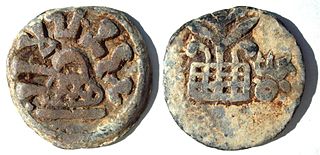
The Chutu dynasty ruled parts of the Deccan region of South India between first and third centuries CE, with its capital at Banavasi in present-day Karnataka state. The Chutus probably rose to power as Satavahanas feudatories, and assumed sovereignty after the decline of the Satavahana power. Except for the edicts of Asoka, the inscriptions of the Chutu dynasty are the oldest documents found in the northern part of Karnataka State, India.

The Karla Caves, Karli Caves, Karle Caves or Karla Cells, are a complex of ancient Buddhist Indian rock-cut caves at Karli near Lonavala, Maharashtra. It is just 10.9 Kilometers away from Lonavala. Other caves in the area are Bhaja Caves, Patan Buddhist Cave, Bedse Caves and Nasik Caves. The shrines were developed over the period – from the 2nd century BCE to the 5th century CE. The oldest of the cave shrines is believed to date back to 160 BCE, having arisen near a major ancient trade route, running eastward from the Arabian Sea into the Deccan.
The Western Satraps, or Western Kshatrapas were Indo-Scythian (Saka) rulers of the western and central parts of India, between 35 and 415 CE. The Western Satraps were contemporaneous with the Kushans who ruled the northern part of the Indian subcontinent, and were possibly vassals of the Kushans. They were also contemporaneous with the Satavahana (Andhra) who ruled in Central India. They are called "Western Satraps" in modern historiography in order to differentiate them from the "Northern Satraps", who ruled in Punjab and Mathura until the 2nd century CE.
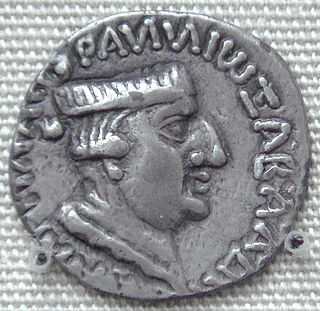
Nahapana, was an important ruler of the Western Kshatrapas, descendant of the Indo-Scythians, in northwestern India, who ruled during the 1st or 2nd century CE. According to one of his coins, he was the son of Bhumaka.
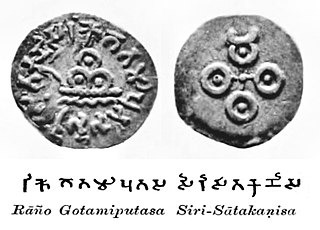
Gautamiputra Satakarni was a ruler of the Satavahana Empire in present-day Deccan region of India. He was mentioned as the important and greatest ruler of Satavahana Dynasty. He ruled in the 1st or 2nd century CE, although his exact period is uncertain. His reign is dated variously: 86-110 CE, c. 103-127 CE, 106-130 CE, or more recently and specifically ca. 60-85 CE.

Rudradāman I was a Śaka ruler from the Western Kshatrapas dynasty. He was the grandson of the king Caṣṭana. Rudradāman I was instrumental in the decline of the Sātavāhana Empire. Rudradāman I took up the title of Maha-kshtrapa, after he became the king and then strengthened his kingdom.
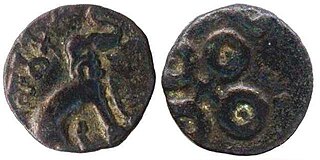
Satakarni was the third of the Satavahana kings, who ruled the Deccan region of India. His reign is generally dated to 70-60 BCE, although some authors have claimed 187-177 BCE, and most recently dated to 88-42 BCE. It was thought there were "two Satakarnis", however, Andrew Ollett argues that there is only one Satakarni, as the alleged first Satakarni is assigned ten years, and the second, fifty years by other scholars, but the only dated inscription of this king is Candankheda seal from his reign's year 30, around 60 BCE, and he ruled ca. 88-42 BCE.

The Nasik Caves, or Trirashmi Leni, are a group of 23 caves carved between the 1st century BCE and the 3rd century CE, though additional sculptures were added up to about the 6th century, reflecting changes in Buddhist devotional practices. The Buddhist sculptures are a significant group of early examples of Indian rock-cut architecture initially representing the Early Buddhist schools tradition.

Simuka was an ancient Indian king belonging to the Satavahana dynasty, which ruled the Deccan region. He is mentioned as the first king in a list of royals in a Satavahana inscription at Nanaghat. In the Puranas, the name of the first Andhra (Satavahana) king is variously spelt as Shivmukha, Sishuka, Sindhuka, Chhismaka, Shipraka, Srimukha, etc. These are believed to be corrupted spellings of "Simuka", resulting from copying and re-copying of manuscripts.
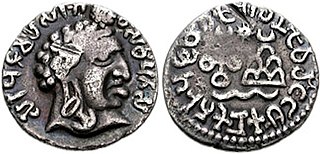
Vasishthiputra Pulumavi was a Satavahana king, and the son of Gautamiputra Satakarni. The new consensus for his reign is c. 85-125 CE, although it was earlier dated variously: 110–138 CE or 130–159 CE. He is also referred to as Vasishthiputra Sri Pulumavi. Ptolemy, the second century writer, refers to Pulumavi as Siriptolemaios, a contemporary of the Western satrap, Chastana.

Ushavadata, also known as Rishabhadatta, was a viceroy and son-in-law of the Western Kshatrapa ruler Nahapana, who ruled in western India.

Yajna Sri Satakarni, also known as Gautamiputra Yajna Sri, was an Indian ruler of the Satavahana dynasty. He was the brother of Vashishtiputra Satakarni. His reign is dated variously: c. 152-181 CE, c. 165-195 CE, c. 170-199 CE or c. 174-203.
Nashik is a historically, mythologically, socially and culturally important city in the northern part of the state of Maharashtra in India. It is known for the temples on the banks of the Godavari and it has historically been one of the holy sites of the Hindu religion. It is one of the four cities that hosts the massive Sinhastha Kumbh Mela once every twelve years.
This article details the history of Raigad district. Raigad District is a district in the Indian state of Maharashtra. It is located in the Konkan region. The Kulaba district was renamed after Raigad, the fort which was the former capital of the Maratha ruler Chatrapati Shivaji Maharaj. The fort is surrounded by dense forest in the interior regions of the district, on a west-facing spur of the Western Ghats of Sahyadri range. The name was changed during the regime of Chief Minister A. R. Antulay on 1st January 1981.

Ishwarsena was the founder of the Abhira dynasty and he started an era which later became known as the Kalchuri-Chedi era. He and his descendants whose names do not occur in the Puranas seem to have ruled over a large territory comprising Gujarat, Konkan and Western Maharashtra. His descendants ruled for nine generations.

Kanha was a ruler of the Satavahana dynasty of India. Historian Himanshu Prabha Ray assigns his reign to the period c. 100–70 BCE.

Satakarni II was the fourth of the Satavahana kings, who ruled the Deccan region of India. His reign is generally dated to 50-25 BCE.
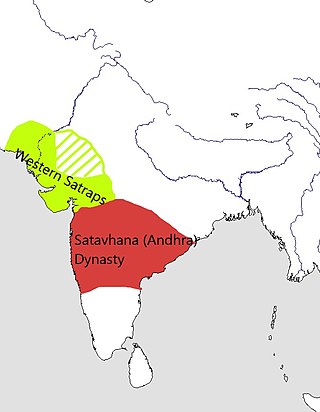
The Saka-Satavahana Wars were a series of conflicts fought between the Saka ksatraps and the Satavahanas during the 1st-2nd century CE. Both sides achieved success at varying points during the conflicts, but in the end, it was the Satvahanas which prevailed. However, constant wars with the Sakas severely weakened them and was a major contributor in their fall.


















